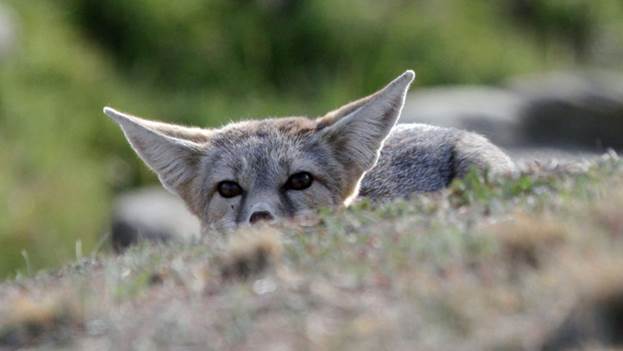
The high-cholesterol fox, also known as the San Joaquin kit fox
By Matthew L. Miller, director of science communications for The Nature Conservancy
Many conservationists call our current epoch the Anthropocene, an age when humanity impacts everything on earth. Not surprisingly, the large human population and its attendant resource use has not been kind to wildlife. A recent report estimated that the world has lost 58 percent of its wildlife over the past 40 years.
Still, some wildlife species adapt and even thrive. Humans also look to technology and science to assist endangered or even extinct animals. This has led to a lot of speculation and even fantasy and has spawned a lot of science fiction that paints a dystopian future inhabited with clones and mutant beasts.
But some of this is not science fiction. In reality, the Anthropocene is already home to weird instances of rapid evolution and adaptability. Some species have made significant changes to thrive in cities. Humans have altered other species through scientific advances. New hybrids have reclaimed novel habitats.
So here are some really weird beasts of the Anthropocene.
The high-cholesterol fox, aka the San Joaquin kit fox that eats burritos and scraps
Cities displace wildlife habitat, of course. But for some adaptable species, urban environments become habitat. Even the most adaptable species sometimes have to adopt radically new ways of surviving. Research has found that urban ants become adept at foraging spilled junk food. City raccoons have become fatter and also smarter, capable of navigating dumpsters and pet doors to pillage new food sources.
And then there’s the San Joaquin kit fox. Critically endangered in much of its California range, it’s actually thriving in the city of Bakersfield. In 1993, researchers found that Bakersfield kit foxes still ate mostly ground squirrels with the occasional meal of human refuse. Fifteen years later, that had changed dramatically. The foxes ate a predominantly human diet. Genetic tests found that much of the fox’s food was high in corn syrup.
The Bakersfield kit foxes had, perhaps not surprisingly, higher cholesterol than their kin in wilder environs. But that is not the threat it appears. San Joaquin kit foxes living on diets of discarded burritos and kitchen scraps actually live longer and breed more successfully, despite the seemingly unhealthy diet.
The coywolf, a predatory hybrid that filled a void
Following the extermination of wolves in the eastern United States following European colonization, western coyotes began colonizing the habitat.
But as they were moving east, coyotes encountered eastern wolves. And bred with them. The coyotes that exist in the eastern United States thus are coyote-wolf hybrids, or coywolves. Determining canid genetics is extraordinarily complicated, but recent genetic testing has offered some clarity. For instance, the wolf genes in coywolves are not those of gray wolves, but of a separate species, the eastern wolf.
As a researcher I interviewed on the topic suggests, though, what is important is not to obsess over species but rather over ecosystems. Ecosystems are healthier when they have top predators. Recolonizing coywolves may play an important role in healthier eastern forests.
Sounds like science fiction: Radioactive boars
Six years after the Fukushima nuclear disaster in Japan, the headlines resemble science fiction: “Thousands of radioactive boars are overrunning farmland,” and “Radioactive boars attack people in deserted towns” among the more sensational.
Hogzilla, anyone? Many have rightly criticized this over-the-top news coverage. While the wild boars may indeed have elevated levels of radioactivity, they aren’t mutant zombies or freaks. Really, it’s pretty simple: When humans leave an area, wildlife thrives. Even in nuclear disasters.
Nowhere is this more evident than Chernobyl. I remember the predictions that this disaster would render the area “lifeless.” But life, truly, goes on. And in Chernobyl, large mammals – wolves, bears, deer, bison – roam in large numbers.
Will there be long-term effects of radioactivity? Undoubtedly. Are there mutants? Probably, but maybe not to the extent first predicted. In reality, wildlife does better following human-caused disasters than humans do.
As for those boars at Fukushima? When humans returned to resettle their homes, there were large numbers of them roving around, but hunters were dispatched to remove them from communities.
Grolar bears: a grizzly bear, polar bear cross
Perhaps no hybrid animal has captured recent attention like the polar bear-grizzly cross, creatively called the grolar bear or pizzly. The polar bear’s habitat is usually inhospitable to grizzly bears. But some believe that as the climate warms, grizzlies have been able to move north, encountering the other bear species and breeding with them. Despite all the press, in modern times there have only been a few documented cases of grolar bears, with the most famous being the one shot by a hunter in 2006.
But, interestingly, at least a few zoos have bred the two species as a promotional gimmick. Some animal enthusiasts gush over zoo grolar bears, calling them “rare” and “special.” In reality, zoos and other animal attractions have a long history of breeding different animal novelties (think white tigers, or lion-tiger crosses known as ligers). This is neither good conservation nor good wildlife education, but the human propensity to tinker will continue. The future of grolar bears in wild conditions, though, is difficult to predict.
